← Back to Testimonial
BHUTAN – THE LAND OF CHANGES OR THE LAND THAT CHANGES YOU
TUESDAY 6TH OCTOBER: We are in a small Drukair plane flying over the flat plains on either side of the Ganges, when suddenly the Himalayan range comes out of nowhere with massive peaks covered with eternal snow. Mt Everest and Jomolahri which we will see from Jomolahri camp with its imposing icy mass in a few weeks during our trek.
We are in Paro and I have never previously in any airport seen travellers getting off a plane and stopping on the tarmac to admire the surrounding scenery and taking photos. My anticipation of being on the Bhutanese soil has been so long that a few tears of happiness start swelling up in my eyes. I straightaway know that this country is going to offer some special experiences and emotions.


Outside our guide Ugyen waits seriously for us holding a piece of A4 paper with my name. Off to Thimphu in a new Hyundai 4 wheel drive driven by Jamyang, such a gentle softly spoken Bhutanese. It is unexpectedly very warm (about 28 degrees). At Hotel Norbuling located in the middle of Thimphu with a view over a stadium where men do archery, we are having our first lunch, being immediately immersed in the Bhutanese food, with rice (lots of it), spicy beef, capsicum in butter, eggs,that we learn to scoop up with our right hand and a lot of laughter. Straightaway, we feel comfortable with Ugyen and Jamyang, as they are such amazing companions.



We visit the Queen’s Charity Centre designed to promote the Bhutanese culture employing handicapped people. We even try some ara made on the premises from fermented rice. Very strong taste and alcohol contents. We only manage a couple of sips. Then we visit the Students’ Art School, where students concentrate on wood carving, embroidery, painting, clay sculpture.



Later in the evening we go to the TashiChhodzong (Thimphu Dzong) which was built in 17th Century. We will find out that most Dzongs were built in the 17th century by the third King, JigmeDorjiWangchuk, in order to unify Bhutan. It is massive, impressive and yet light, as it has beautifully decorated wood carvings. It comprises a Buddhist temple and the King’s office. From a lookout we can admire the Dzong coming to life under white and red lights as the night spreads over town.



WEDNESDAY 7TH OCTOBER: We wake up refreshed after a good night, despite the barking dogs. We will get used to the dogs barking nearly every night and will blissfully enjoy the nights without any bark and howling. We drive along the Wang Chu following a narrow valley lined with pine trees. The road is winding, with lots of potholes. Again, we will discover that this is the normality for Bhutanese roads where the speed limit is 60km/h and the average is 30 km/h. It can take you 12 hours to cover just over 300km. We arrive at the bottom of Tango Dzong and to reach it we walk up a pleasant path meeting monks along the way who are having celebrations with prayers, blowing their horns and tea and biscuits which they offer to us, while chatting on their smart phones. The Dzong is impressive with a nice view.
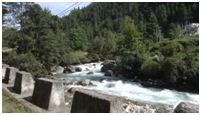


We have a picnic lunch near the Wang Chu (chu meaning river and water in Dzongkha- national language of Bhutan). Picnic lunches are pre-cooked, stored into four small aluminium cylindrical containers put together in a large plastic insulating container. It is so easy to carry and to keep the food fresh and warm.

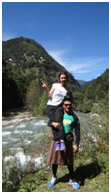

From the start we are building an amazing friendship with Ugyen who is funny as well as very knowledgeable and warm. On the way back to Thimphu we stop at aChorten with a prayer wheel that keeps turning clockwise with the flow of a small stream. We will see so many of these chortens during our trip.
We visit a textile manufacturing place where ladies sit on the floor weaving intricate patterns of their choice. Weaving is a major activity in Bhutan. They produce material out of cotton, wool or silk or a mixture for the confection of kiras (the women’s traditional dress) and ghos (the men’s traditional outfit).


Later on we go to Karma’s Coffee Shop (the only one in Bhutan) with Ugyen, his lovely and well-educated wife Yuden and his cheeky and cute 6 year old boy Damchu. We order all kinds of teas and drinks, but no coffee.

THURSDAY 8TH OCTOBER:
We start on our great adventure eastwards into the heart of Bhutan. Ugyen has decided to go apple picking on a farm to bring apples to Kelzang (the teacher friend who came to Australia in 2005 and stayed with us for two weeks and who is the instigating reason to travel to Bhutan). The apples are tiny and hard, but Ugyen and Jamyang are up the trees and they also collect the fallen apples. Ani follows. I end up in a cabbage patch. It is all fun.



Then along the road we find little stalls selling better apples and the freshest walnuts.
Every time you cross another district – called Dzongkhags – and they are 20 of them – you need to report your entry and your exit. So you have to make sure that the paperwork for tourists is correct, as we will find out when in a few days we try to enter Sarpang District without any written permission.


We continue on this winding road with trees of all kinds everywhere – juniper trees, rhododendrons, pines, firs and more – 70% of Bhutan is forested and they are proud of their forests. Most of the 30% is either cultivated or above the tree-line. Then suddenly you come out of the forest at the Doche La (La meaning Pass) at 3050m and you stop breathing for a few seconds as the view over the northern highest peaks (with GangkharPuensum at 7541m being the tallest of all) is incredibly beautiful. We jump out of the car and run with excitement. It is cool but we don’t feel the coolness. There are 108 chortens built in memory of the Bhutanese people who died fighting the Indians recently.


We have a warm milk tea in the cafeteria at the Pass with its large windows to enjoy the view and warm atmosphere.
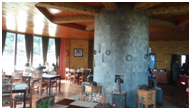


We drive down towards WangduePhodrang and that’s when we start experiencing the miserable state of the roads. There were no roads back in the 60’s. So Bhutan built major roads across the country, but now these roads are being upgraded. Indian companies work on the roads, but there does not seem to be any practical plan how to tackle the upgrading. Workers have few machines and they are supposed to work at night, but they still work during the day. This means that not only most of the roads are full of potholes, gravels, stones, but if you come across a machine digging into the side of the mountain moving rocks or breaking rocks, you have to stop and wait patiently. There is no safety at all. So you have huge machines balancing precariously on the side of the mountain over a pile of loose stones and you pray that nothing will fall on top of you as you drive past. Plus the roads are so narrow that two cars passing have to squeeze slowly by. It is a frightening but “amusing” experience.

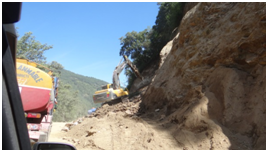
We are passing Lobesa after we have a lovely lunch and Punakha which used to be the capital of Bhutan with a majestic Dzong at the intersection of two rivers, Po Chu – Male River and Mo Chu – Female River. We continue along a very narrow and bumpy gravel road where we start our white water rafting journey down both rivers. The weather is exceptionally warm and so sunny. A group of very young Bhutanese boys take us down on a rubber dinghy. We convince Ugyen to come along with us although he is petrified of the water and cannot swim. It is his second time white water rafting.

Two hours of bliss and fun and then we visit Punakha Dzong.

Later on we walk along a swinging bridge over the Mo Chu. It is covered with prayer flags. Prayer flags need to flutter in the wind so the prayers are dispersed across the land, and they are placed in strategic points, such as bridges, passes, chortens etc.

We stay at Lobesa Hotel which has only been built two years ago and our room offers such a magnificent view of the valley. We love it, especially our white towels folded as white swans!

FRIDAY 9TH OCTOBER:
We follow the road north towards Gasa Springs. Golden rice paddies weave between the mountains and the river. We hear a police siren in the middle of nowhere and we are puzzled about what is happening. Ugyen warns us that we have to stop that it is possibly the Queen Mother’s escort. Next few seconds four cars come down from Gasa. In the front jeep four soldiers ask us to stay on the side of the road. Three other cars follow, but we don’t have time to see who is inside each one. Definitely it is the Queen Mother’s escort.Along the way we spot a bright green snake with black lines slithering along the road, then a family of brown monkeys.

We reach Gasa and the picnic lunch is served in a small hut near the hot springs.

Ugyen and Jamyang have time to play a quick gamebeing a mini version of pool played with a flat putt on a square table.

Then we enjoy soaking ourselves in hot water even if it is smelling of sulphur.

SATURDAY 10TH OCTOBER:
We leave Lobesa and head direction WangduePhodrang where we stop briefly. It is a “booming” town with new flats for the people and their families working on the new hydro-electric project nearby. An Indian company is in charge, but Bhutan will be able to produce so much electricity that it will be sold to India to refund its debts. We follow Puna Tsang Chu which is a beautiful fast flowing river. We are heading south and it gets warmer and warmer.

Finally we arrive at Damphu around 4pm and we spot Kelzang in the street straightaway. I feel so happy to see him again and he is a bit overwhelmed as I give him a big hug in front of everyone in the street.
We drive to his house which is on the side of the road 4 km south of Damphu. We meet his family, his wife Sangay, his daughter Sonam (who is 15) and his son Pema (who is 12). He has another daughter Karma living in Thimphu who is 21 and has just finished her studies in nursing.
We stay at Kelzang’s house for three days. In the afternoon we walk around Damphu which is a typical small town with the main street bordered by shops.
In Bhutan the tradition is to chew betel nut wrapped in a leaf with grinded lime powder. It is a mild narcotic. Because it is a tradition over centuries it is not illegal. It makes your mouth go red and the lime destroys the teeth. Later on at a central school we will see a poster advising the new generation not to chew betel nuts because of health problems. Ani has a go, but spits it out nearly straightaway.

In Damphu we see a meat shop for the first time. They sell mainly chickens and also fish.

SUNDAY 11TH OCTOBER:
In the morning we go to the local market. Everyone who grows something is there to sell it. It is very friendly and the amazing thing is that all vegetable products are organic and fresh. Then we go and watch teachers from Kelzang’s school compete in an archery match. It is interesting to see how the games are organised. There are 3 archers in each team. They aim for a target which is low over the ground, 150m away. If an archer has reached the target or the arrow hits the ground very close to the target, his team members do a little dance and song facing the target. The spectators have to hide behind a stone wall with little peep holes so that you can watch. The archers not only have incredible coordination but also very good eyesight. Only men do archery when they reach the age of 18.


In the afternoon Ani washes her clothes Bhutanese style, outside in cold water.
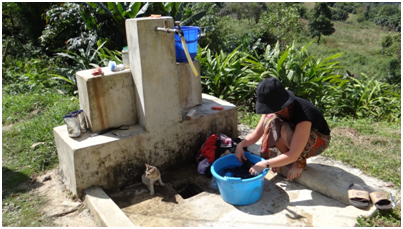
We also visit the Central School of Tsirang District. Central Schools are a new idea with one central school in each district to test how it is working. They cover all grades in both primary and secondary. Some children come from faraway places and board at school. The education is of a high level, all done in English with only one hour of Dzongkha study per day. The students appear very happy as coming to school is less stressful than doing hard manualwork at home. We see lots of wise sayings pinned on the walls everywhere with the main message being to respect nature, to keep the environment clean and to keep oneself clean too.

MONDAY 12TH OCTOBER:
We are off to school with Kelzang, to his brand-new primary school built before a road is built. This is typical of Bhutan. The students are lovely. They do their prayers first, followed by a speech from the captains and then the principal who introduces us. Ani does not stay, but I stay all day. Education is not stressful, the students are very polite but also relaxed. They learn a lot by repeating and memorising. I basically take over the teaching as all teachers disappear… But it is a lot of fun. Children have amazing high pitch voices and they love singing their traditional Bhutanese songs which are so melodious.

Then I ask children to do some special drawings, so I end up with pink snow leopard, dolphins with duck bills, mountains of Bhutan looking like Egyptian pyramids, a black-necked crane with a horse tail and messages such as “long live Miss Michele”. And then we partly have to walk back home with some students following us. Children are so friendly and inquisitive, as well as polite and respectful.

We get invited to have dinner at Jambe’s, another teacher’s house. We have orchid soup! We also have ara with bits of scrambled eggs in the glass. You drink the ara and then eat the eggs. Teachers intend to build themselves a special stompa for the school and they ask me for a donation and promise me that both Ani and my name will be engraved on the school stompa.
TUESDAY 13TH OCTOBER:
We are leaving for Gelephu Hot Springs near the Indian border. Ugyen and Jamyang come to pick us up early. Kelzang drives his car and another teacher friend comes along too. It seems that teachers can get leave now and then easily. After a few minutes Kelzang decides that I can drive. It is a lot of fun as it is the time students walk to school and when they spot me at the wheel, they bow to me with their hands together and giggle at the same time. I feel like the Queen Mother driving by. You have to be careful avoiding cows, dogs, children, cars, trucks, potholes. But it is an easy road compared to others.
Finally we arrive at the immigration booth to enter Sarpang District and we are told that we will have to pay a fine because we have entered Sarpang without permission, etc. etc. Then I realise that the booth is not at the border of the district. It is very hot and Ani and I find some shade at a little stall across the road belonging to a lovely Indian woman who gives us a banana each. They are delicious, so we buy a bunch from her. Despite at least one hour of discussion with the immigration officers and a few phone calls here and there, Ugyen keeps being optimistic that we will get permission to enter Sarpang District and that we will not be fined. That’s what I like about Ugyen, he is always finding a solution and remains optimistic. The officer even asks me to sit with him in his booth. I hesitate and then realise that it is air-conditioned and pleasant, so I call Ani to join me. Eventually off we go after two hours with our modified permission papers.

Then we arrive at Gelephu after following a road bordering India. The landscape is so different here with the hills in the north very much like our Australian Great Dividing Range and the plains on our right and wide river beds with little water and lots of large pebbles. Betel nuts grow on a type of palm tree and it smells so strong and horrible when fermenting.We arrive at Gelephu with lots of Indian migrants queuing up at the Immigration Office where we have to go to have our new papers stamped. We have lunch at Gelephu.

After lunch we keep driving to the Hot Springs. Ani mentions that hot springs on a hot day is not exactly the ideal thing to do. But here we are. The water is also sulphuric, but the baths look like wells. We are all squashed in. Only Bhutanese people come here as it is not well-known. We are not staying very long as it is too warm.

Back home, we meet Kelzang’s oldest daughter, Karma, who is the same age as Ani and is lovely. It is sad that we will only meet Karma briefly. This is our last night with Kelzang, but we will see him again in Paro before our departure.

WEDNESDAY 14TH OCTOBER:
We are leaving Kelzang with a few tears we are both holding back. He is such a nice man. The owner of the house, Kamala, who is Indian, wants to see us. She embroidered some placemats for us. People are so generous and hospitable. Off we go, direction back to Wangdue and then east! The road is so dangerous. A truck had fallen way down the side. Fortunately the driver was fine. We see our first yak and it poos right in front of us.

The plan was to push all the way to Bumthang, but because the road is so slow and tiring, Ugyen decides we stop at Trongsa as it is nearly night time and we don’t want to be on these roads at night. We are so happy. It is a very nice hotel (Yangkhill Resort) up a hill with the Dzong shining on the other side of the valley.

THURSDAY 15TH OCTOBER:
We have time to visit Trongsa which is small but cute and TrongsaDzong. As we get up, we discover what the resort looks like with beautiful individual rooms among lots of vegetation and especially Australian native bottlebrushes.

First I need to go to the bank and change some Australian dollars into Nulgrum (A$1 is NU50). Bhutan only uses notes, no coins at all. It makes it so easy. The bank is called BOB, or Bank of Bhutan! Ugyen decides to change the money for me as it is not simple. First he has to fill in a form to take to one teller. Then once the form stamped he goes to another teller to get the money. People do not queue. They all cram over the counter looking at what everyone else is withdrawing. One older man asks Ugyen to count his money.

Then we visit the Dzong. In front of it there is a massive impressive cypress tree which must be at least 200 years old.

Ugyen explains to us the philosophy of Buddhism, the different buddhas, the meanings of all the paintings and representations, the history and steadily we are trying to make sense of it all.
Then we walk to the Tower Museum above the Dzong, up a few steps slowly puffing and huffing as we are at 2500m. The Tower was used to check for enemies and invasions from its prime location. The presentation in the Museum shows us the history of the area with lots of craft and old weapons, such as swords.

It is time to continue east along this treacherous road. We cross a convoy of cars and buses full of monks, with the second car carrying the very colourful coffin of an important monk who passed away, all the way to Thimphu to be cremated. Sooner or later (whichever way you want to look at it) we arrive in Bumthang. But we are stopped at the entrance in front of a petrol station because it is the day the locals bring their gas bottles to be refilled. But it is traffic chaos as everyone parks there, tries to drive through both ways when there is space for half a car. So Ugyen and I step out of the car and control the traffic, letting some cars go one way and stopping the others coming the other way so that we can untangle this mess. To my big surprise, the drivers are following our big arm movements and comply amicably.

Our hotel is outside Bumthang. We have time for a walk towards Bumthang, but we do not quite reach it. Ani is all excited because marijuana plants grow wild alongside the road everywhere in this area. Bhutanese people give it to the pigs to eat.

Ugyen tells us that this afternoon the Queen Mother’s convoy got caught in a landslide on the road we took yesterday. The first army jeep got swept away and three guards die and only one managed to jump out. The Queen Mother’s car had time to stop. It makes us realise that the road is too dangerous.
FRIDAY 16TH OCTOBER:
We continue east on our winding and slow road, with the slightest improvement on its condition. We reach the highest road pass, Trumseng La at 3554m, with sleet and light snow. It is cold and windy and we don’t stop. On the way down to the other side of the mountain, we come across a vertical waterfall framed by a rainbow. It looks magic. Then we keep going and stop at a stompa at the top of that waterfall to have lunch. What an idyllic dining room!

After lunch we walk for a little while. Then we reach another tall waterfall with a little lake at the bottom. If only the weather was warm, it wouldbe magical to get splashed.

We see our first langur monkeys which are smaller than the brown monkeys, with a beautiful fur and a long dark tail. They are very agile hopping from branch to branch.

This area is too mountainous and too cold to grow rice, so people grow buckwheat and corn. They also eat more potatoes.
Then we come across the most bizarre incident on the road. One truck was ramming into the back of another truck that was jammed sideways under a rock. We realise that the second truck had its engine removed and could not go anywhere. We watch for a while and then manage to squeeze through and laugh a lot wondering if they will still be there when we return.

Late in the afternoon we arrive at Mongar. Again Ugyen agrees that we should stop there although we were meant to continue to Trashigang. We are tired. Our hotel is not far from the town with another magnificent view. The town of Mongar does not offer anything special. We walk around. We see a game of soccer played while cows are grazing on the field and a post office in a cute little white and blue house.

SATURDAY 17TH OCTOBER:
We have decided when we are back in Bumthang, to fly from there back to Paro instead of going back on the same dangerous road if we can. We will miss Gangtey but truly I don’t know how we could have done all this when you are on the road for hours to cover a few kilometres. So Ugyen is trying his best so we can have seats on the domestic flight with DrukAir.
More stoppages along the road: Ugyen even helps to move some pine tree trunks and then we come across the biggest earthmoving effort. So Ugyen sends us to walk down the road while they wait to get through. It will take over one hour

Indian workers come to Bhutan under a contract to work on the road. Some build little walls out of stones that they break manually.The whole family works, father, mother, children. They live in small tin shacks on the side of the road. We see brown monkeys up in the tree and a man making lemongrass oil in a very rudimentary pot alongside the road. The smell is pungent and beautiful. The Bhutanese lemongrass is slightly different from the one we have in Australia as the leaves are much greener and softer and the plant grows wild in the mountains.

We arrive at our hotel outside of Trashigang for a late lunch. The view is unbeatable from the dining room.

Ani is resting while I wash our clothes which I hang on a clothes line outside in the wind. Most valleys in Bhutan are very windy. This area although being mountainous is drier and warmer. The cicadas are singing everywhere, even if the temperature is fairly low. Then we go to the Dzong which was partly destroyed by an earthquake two or three years ago. It is being repaired steadily with the help of the local community voluntarily. Trashigang is a nice little town very compact and friendly. I feel at home as this area has been planted with lots of white gum trees (Native eucalyptus from Australia).

Ugyen is from this area and tomorrow he will take us to his aunt’s farm in the hills.
We walk around town and to our big surprise we see a little girl with her dog on a leash. It must be the only one in all of Bhutan. Then Ani decides to go to the hairdresser. She has henna put in her hair, a trim and during that time we go and buy a bottle of Druk beer that I want to try. We drink the beer in the hairdresser shop watching Ani having her hair done. In the meantime I go in and out of the shop and the local children start talking to me. They have a difficult time to remember our names. So later on I can hear them practising singing “Michele Ani Michele Ani Michele Ani” on top of their lungs. Most Bhutanese find it difficult to pronounce my name. So I have become Michelee which I think is very nice.

At the resort there are large groups of French and German tourists. We stay on our own.
SUNDAY 18TH OCTOBER:
Ugyen is taking us to his aunt’s farm. We drive north from Trashigang. The road is easy and beautiful. Then we follow a small gravel road with lots of bends up the mountain side. We finally leave the car at a monastery where a young American teacher with a group of secondary school students is cleaning up the area. We have a short talk. He has been in Bhutan for four years and loves it. He has come with an organisation called Bhutan Canada. This organisation has been operating for many years and helped the Bhutanese with their education.
We walk through paddocks and farms following a little path. It is so peaceful and pleasant with a gorgeous view of the mountains. We arrive at the farm where Ugyen’s aunt is with another couple of ladies. Her husband is working somewhere outside. She has prepared a nice lunch which we have inside, starting with ara and homemade cheese broken into pieces dumped in the ara. The interior is very simple and dark. Under the roof they store corn to dry and you go up on a very narrow and steep wooden ladder. Ani goes up with Ugyen.
Ani makes friend with a 4 year girl named Jamyang. Here boys and girls have similar names. Names mean something and are given by a priest at birth. Ugyen’s aunt had a lot of dried chillies that she wanted to give to Ugyen to take home. Next to the house there is a little village temple where the locals can go and pray
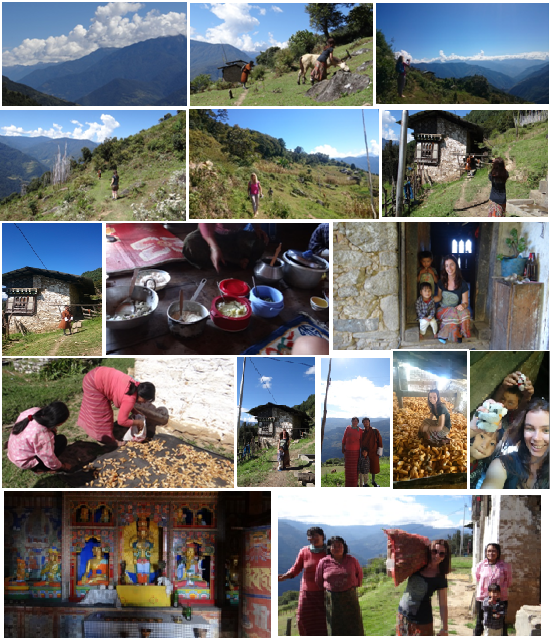
On the way back we stop at Dom Kora, a special place where the second Buddha called Guru Rinpoche meditated in a hole in a rock. Many old people were praying while turning the 108 wheels on a wall built around a large tree. We walk towards the river and Ani and Ugyen try to climb some large rocks.

In the evening we meet PemaDorji (the teacher who came to Scotts Head in 2005 with Kelzang) with his wife and youngest son who is 7. We have dinner together at the resort, but it is very noisy and they feel a bit uncomfortable with the loud tourists around.

MONDAY 19TH OCTOBER:
We are heading back west to Bumthang for the JakarTshechu Festival. We have a quicker and easier time on the road. We stop for tea at a resort just before Bumthang, calledValley Resort, and the managerSamgay is the one who has organised our air tickets to Paro. Then we go to another hotel called The River Hotel which is managed bySamgay’s father and mother. We have a little potbelly in our room, so Ani lights a nice fire as Bumthang is quite cold at night being at 2500m.

TUESDAY 20TH OCTOBER:
Bumthang is a weird town, with very wide and straight streets lined up with tiny shops, so much like the American Wild West. But the atmosphere is very friendly. We drive to JambayLhakhang (temple) built in 659 and restored since. There are so many people praying, giving a special powerful feeling. Ani and I love this temple. Outside there are people selling jewellery and handicrafts.

Then we drive to KurjeyLhakhang (another temple) built in 1652. The valley of Choskhorwhere all these temples are is very sacred and special with the Bumthang Chu flowing through it.

Then we walk to ThangbiLhakhang passing a suspended bridge. But the temple is under renovation.
After we have lunch in a small restaurant in town and look for presents,Ugyen decides to hire bikes. We ride our bikes along a fairly flat road east of Bumthang towards a sacred place, Me Bar Tsho, a small lake in a deep gorge in the middle of a torrent. It is very spiritual covered with prayer flags, incense, butter lamps and the cones made from mud and ashes of dead people. Ugyen and Ani are zooming along the road. Ugyen looks funny with his gho flowing in the breeze. I struggle at the back. But I make it to the lake and back. On the way back, Ugyen and Ani have time to stop at The Valley Resort for a tea while I am pedalling along like mad.

WEDNESDAY 21ST OCTOBER:
After helping us to put our kiras on for the festival at the Dzong, Ugyen and Jamyang leave us as they have to drive back to Paro (it will take them 12 hours). Samgay takes us by car up to the Dzong. There are so many tourists dressed in normal clothes. We are the only ones walking in without a guide and we have to sign ourselves in. But the police in charge waves us in. There is a series of dances performed by young men leaping and twirling, there are clowns wearing red smiling masks, there are groups of young women singing and dancing with their hands. Someone explains in English the meaning of each performance which basically is meant to get rid of any evil and purify oneself.

We then walk down to town for lunch. In the afternoon we decide to walk back to the suspended bridge and JambayLhakhang in the opposite direction. We arrive at the end of a prayer session with the monks chanting and banging on the vertical drums and blowing their horns. It is awesome. Ani spots a nice old monk who smiles at us. Shily she asks him to take a photo together. He is so gentle and holds Ani’s hand. We find the lady selling the 4-direction pendant meant to bring you good luck (TashiDelek) in life and Ani buys one. On the way back to Bumthang we come across this house selling handicraft. They have the most amazing wool jackets. If only we had more space in our suitcases! We pass a beer garden Bhutanese style.

THURSDAY 22ND OCTOBER:
Samgay takes us to Bumthang airport and we wait in the cold wind for a long time. In 25 minutes we are at Paro airport with Ugyen waiting for us again holding the same poster with my name – and that’s when I realise that my last name was spelt “VICATIO” which I did not notice when we first arrived. It is nice to be with Ugyen and Jamyang again. Paro appears more modern and cleaner than Thimphu. Bhutanese people are dressed more in fashion, especially the young girls. There is a nice atmosphere with lots of handicraft shops of high quality. We are staying at the Metta Spa Resort which is a few kilometres west of Paro. We organise our bag for trekking and I have a wonderful massage on a heated soft mattress.

FRIDAY 23RD OCTOBER:
We start our trek after meeting our trekking gang (the horseman with ten ponies, donkeys and mules, the cook Phub, the staff/helper Lhakpa). We will spend seven days together and have a lot of fun. We follow the Paroriver. It is easy as we walk along the road to start with until we come to a gate to JigmeDorji National Park managed and controlled by the army. Our names are recorded in a book. Then we follow a small track. In the early afternoon we arrive at Shana Camp at 2850m in altitude, where there is even a grocery shop after covering about 15 km. The cook Phub is amazing the way he can prepare a 5 course meal sitting down in a tent with a 2-gas burner. And he does this twice a day, once early in the morning preparing the picnic lunch and then in the evening. Our breakfast will be a variety of trials and errors and eventually we will tell him that we prefer porridge and eggs with toast, than baked beans or small sausages. Then he cooks again for the crew as they eat chillies and lots of rice with every meal even breakfast. In the night we are cold as the sleeping bags are not adequate (and this will be our only complaint during this trek).

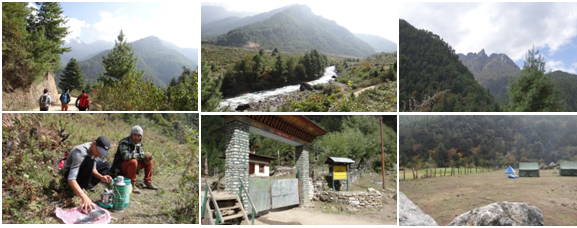
SATURDAY 24TH OCTOBER:
Today we walk 22 km going up and down on a narrow track very stony, as the large pebbles and boulders have been laid down to stop the soil from washing off in times of heavy rain. It makes the walking difficult and you have to constantly watch where you put your feet. We walk through such beautiful forests with an amazing variety of trees and some have gold or crimson red leaves. I want to take a photo of the trees, look up and fall backwards. Fortunately the rock behind me is rather round. Just a few elbow scratches. We keep following the Paro Chu which is flowing like a torrent. We come across a Bhutanese with wild honey combsthat he has found somewhere in the forest or under the rocks. We always have lots of ginger milk tea to keep us going and combat altitude. After a few kilometres around a bend Jomolhari comes into view as we reach a chorten with flags on a bridge over the river. It is so beautiful. We continue up to Thangthangkha camp at 3610m. I am starting to feel the altitude but I am still fine. Again we are very cold in our sleeping bags even with thick socks, thermo underwear, thick jumpers, scarves, abeany. Ani even wears her ski jacket.

SUNDAY 25TH OCTOBER:
We wake up and it is all frosty outside. We warm up with a nice cup of milk tea and we start again for another 19 km towards Jangothang at 4080m. The climb gets harder. The forests get thinner and are replaced by alpine meadows where yaks crossed with cows are grazing. There are solid but with a much lighter hide with some white markings. We cross a few farms. There is even a wood factory making planks. Another day I will see a caravan of ponies carrying those planks up the range. Just before reaching the camp in the afternoon we come across the village of Dangochang where a new school called Jomolahri Primary School has been built. Because it is Sunday some young children are playing soccer. Ani and a nice English lady join them and then Ugyen and Lhakpa. The children are so happy. When we start walking again that’s when the altitude gets to me. I feel dizzy, slightly headachy and very lethargic. Lhakpa stays with me and shows so much compassion. I even start crying as I feel tired, but he finds nice words to comfort me. Finally we reach Jangothang Camp with the incredible view of Jomolhari peak just behind our tent. There is a hut where we warm up.

MONDAY 26TH OCTOBER:
Today is a rest day. Ani wakes me up at 5:30. I step out of the tent and turn around. I think my eyes are going to pop out of my head or my brain is going to explode. Jomolahri is a pure white looking massive while all around is in the dark. No words can describe the beauty of this mountain. I decide to go to the school and help. Ani continues the track with Phub up to two lakes. We both have an amazing day. There are only 15 young children at the school with two teachers. They are so isolated, but the Government is pushing education in the most remote areas of Bhutan. The school closes between November and March during the harsh winter months. The students are very polite and lovely, but also extremely cheeky and lively. I am not prepared, but we have fun together. I stay until lunchtime and walk back to camp.
Ani comes back later in the afternoon so enthusiastic about her walk. There are two beautiful lakes. She saw blue sheep and a vulture.

TUESDAY 27TH OCTOBER:
Time to separate. Unfortunately I know I will not be able to climb any higher than 4000m, but Ani wants to keep going. Ugyen offers that she joins another group with a young Thai lady, Fong. I come back down with Ugyen, Lhakpa, the horseman and Phub. The walk down seems to be a lot easier. I walk with Lhakpa while the others are with the horseman. We walk a good pace. Then Lhakpa stops and I keep going, flying along. I just pass the Chorten when I hear shouting. Lhakpa is running to catch up with me and Ugyen saw me from the chorten where he was with the horses. That’s where we stop for our camp. Ideal spot as we are on our own. The wind blows up the valley. I go for an hour walk along the stream towards SoiYaksa. It is so pleasant and peaceful.
Phubmakes me a pizza. We light a camp fire and Phub and Lhakpa start singing traditional Bhutanese songs. We laugh a lot. (Ani has taken my camera, so I don’t have photos).
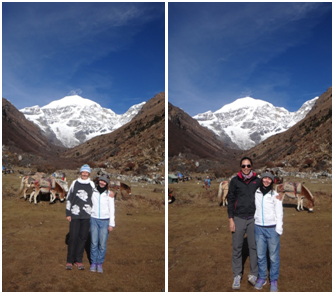
Ani has a wonderful climb again along the two lakes, but this time she does not see any blue sheep. She walks up to the highest pass, the Bhonte La at 4890m. She finds the climb hard because the path is very narrow with loose stones and gravel. But she does not feel the altitude. She covers 16 km. She camps at Soy Yaksa at 3800m which is just across the mountain from our campsite near the Chorten.

.JPG)
WEDNESDAY 28TH OCTOBER:
Lhakpa and I start walking at 8am. We go a good pace. We pass lots of caravans with tourists and working horses carrying amazing loads. We pass men carrying large sections of electricity poles that are being erected in the most remote parts of Bhutan. So our going is quite slow. We reach Shana Camp and we keep going as Ugyen mentioned about another camp further down. But still no sign of our caravan.So I ask Lhakpa to teach me some Dzongkha. I learn “NgaCheytsucharoeen” means “We are friends”, but there is no word for “we” as it is made of “I” “You”. Tsu is for the plural and can be placed before or after the noun. “Charo” is the only logical word in the sentence as it means “friend”, but it might mean something else too? As to the meaning of “een” I still don’t know. We will find out that the horseman who had gone home for the previous night near our camp, had found it difficult to gather his horses. They had left camp around 10am. We set camp on the horseman’s sister land. She has a young boy who is so lovely, but because they speak no English it is so frustrating to communicate.
Ani walks between SoiYaksa to Thombu passing another pass, Takhung La at 4520m. She is happy as she and Fong can sleep in the yak herders’ hut with a fire. It is the only night she will be warm enough.

THURSDAY 29TH OCTOBER:
We are waiting for Ani. . Everyone has decided to stay at the camp to welcome Ani and to say goodbye to her. In the meantime I decide to go for a walk along the road leading from Shana to Paro. It is pleasant except for a few cars that create a lot of dust. I spot Jamyang driving up the valley. He is coming to pick us up. Then I come back at lunchtime. Ani and her group are supposed to arrive back around 1pm. So we drive to the national park gate, then to Gunitsawa. Ugyen tells me I can start walking towards her. But the climb is very loose and slippery and I only have my thongs on. So after a while I stop and wait for Ani. First the English couple is coming down with legs feeling like jelly. Then Fong and finally Ani. She looks tired but so happy. It was very hard as they climbed down for over three hours from Thombu La at 4270mm down to 2880m. We celebrate with a glass of Takin Red Wine and small cakes. Then we say goodbye to our trekking group. We drive to our hotel where we are so happy to jump under a hot shower.

FRIDAY 30TH OCTOBER:
Despite Ani being still recovering from her 7-day trek at altitudes over 4000m, Ugyen, Ani and I are going to Taktsang Monastery instead of having a day of rest. Ani wants to go up on the back of a small horse. But the horse does not want to move, even when Ugyen pulls so hard on the rope to give him some blisters. So I walk up and both catch up with me when we get to the Cafeteria which is about half way. We keep going up and then we have to walk 700 steps down. Quite a few tourists, especially Indians, but it is pleasant,despite the number of footprints you can see on the sandy soil. It is quite amazing where it is built.
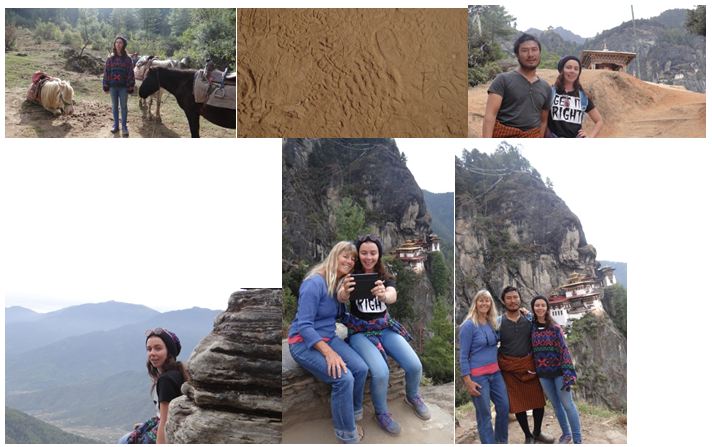
We visit the inside and what is extraordinary is how the rocks protrude in each room here and there. You have to be careful where you walk. Guru Rinpoche flew on his garuda (tiger) to this place to meditate. Then Ani with the help of Ugyen puts her own prayer flags up in front of a waterfall.
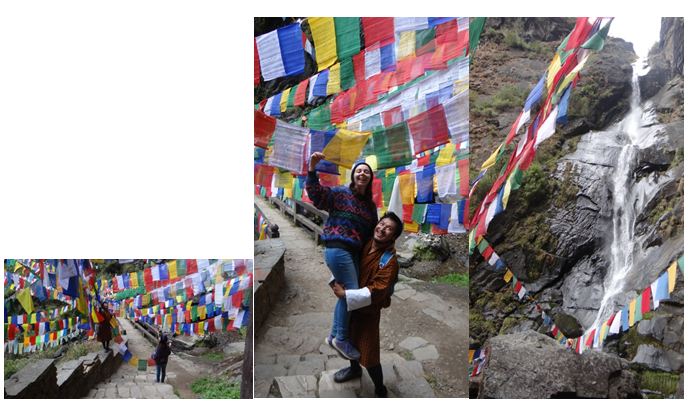
Ani keeps on looking at the rocks and believes it would be the best place to do rock climbing. We laugh about it as all these places are sacred and protected. It is about 2pm when we have lunch in town. We do some shopping and then Ani has a hot stone bath. The bath is ready and they bring this huge red hot rock with prongs and drop it in the water just outside the bath tub made out of wood. Ani enjoys her hot bath.
Ani, Ugyen, Jamyang, Phub and myself are going to a night club called Insomnia Club. Fong and her Japanese colleagues with their guide are also there. The DJ is playing some typically disco music, not really my style nor Ani’s but the rhythm is good. So despite that there is hardly anyone yet at the club we start dancing. We are having fun. More local people arrive, mostly young men. A drunk young Bhutanese woman asks me if I live here. I wish I could say yes. At 11:30 Jamyang drives me back home and Ani stays. She will come back to the hotel around 3 or 4 in the morning.
SATURDAY 31ST OCTOBER:
Ani is not feeling well and very tired. Ugyen and Jamyang come in the morning to drive to Haa Valley. Ani does not want to come, but we convince her to join us. Unfortunately she is quite sick. We stop on the side of the road, but we push on to Chele La at 3988m. The road is very winding for Ani. So we decide to turn around at the Pass. As we arrive there it starts snowing quite heavily. We laugh a lot. There is a group of Indians who are having fun taking photos under the snow. We all squeeze in the car to share our picnic lunch. More laughter. Back to the hotel we relax watching “Catch me if you can” with Di Caprio.

SUNDAY 1ST NOVEMBER:
Ani feels tired so she relaxes in the hotel. Ugyen and Jamyang take me to a bridge from where I can cross the Paro Chu and walk along the river. I decide to walk towards Paro. The weather is gorgeous. I feel relaxed and free. I am extremely happy. I reach Paro and I see a real estate. So I ask them about renting an appartment or a house. It is possible with enough notice and the price is so cheap. All places are unfurnished, but it would be so easy to buy a couple of things. I am seriously thinking about coming back to Paro and teach for 6 months in the future. Then I reach the Sunday market. So many fresh and beautiful vegetables. Then I spot huge hearts of yaks, yak meat and even two yak heads.
Then Ugyen comes with his wife Yuden in her car and their boy Damchu and we drive to the ParoDzong on the other side of the river. Ugyen lets me drive for a little distance. The Dzong is impressive and beautiful. Later on we meet Kelzang who came by himself to farewell us and we go with Ugyen, his family and Kelzang to a restaurant in town. Damchu is such a lively boy full of wits and warmth. Time to say goodbye to Yuden and Damchu and I feel like crying.

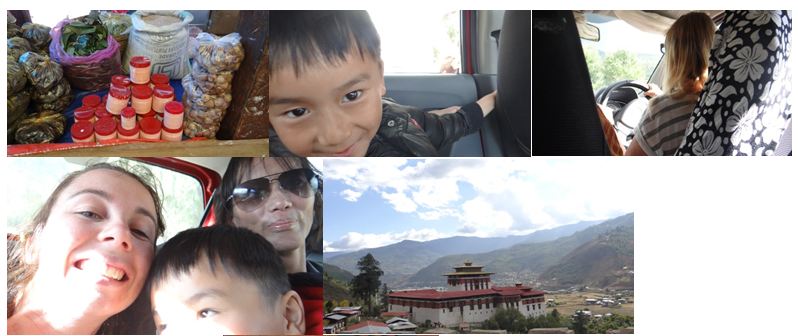

TUESDAY 2ND NOVEMBER:
This is our last day. I cannot deny I am feeling sad and already nostalgic of this country which has brought memorable experiences, not only because of its natural beauty, but also because of its architecture, its philosophy, its simplicity, its amazingly warm and honest people, its smily and respectful children, its sunshine, its majestic mountains, its delicious food, its new friendships, and so on. We drive to the airport around 9:00am to catch our plane at 11:00 am. We don’t know how to say goodbye, because we will see one another again or because we leave amazing friends. Wehug Ugyen, Kelzang, Jamyang and we go into the terminal. We have time to buy a couple more souvenirs and we take off.

I think the photo of Damchu sums it all up! Yes, Damchu, you are right “It is a victory!”

